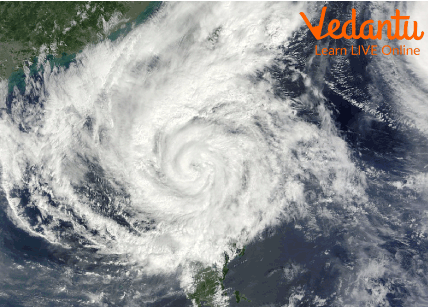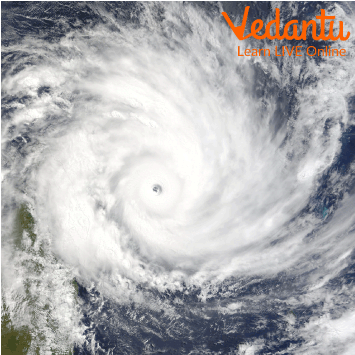




What is a Cyclone for Kids?
Whenever whirlpools are formed in the atmosphere due to specific wind masses, it is called a cyclone. Cyclones are the deadliest of atmospheric disasters! These are areas of low pressure, around which lines of rising air pressure are found! In this, the air pressure gradually increases as we move from inside to outside.
Therefore, the speed of wind is transmitted from the periphery to the centre, whose direction is anticlockwise in the Northern Hemisphere and clockwise in the Southern Hemisphere! Their shape is circular, elliptical or similar to "V". Cyclones are considered important from the point of view of weather and climate because at the place where they reach there is a sudden change in the amount of rainfall and temperature.
Facts About Cyclone
Cyclones are the most dangerous natural hazard to people.
The early or weak phases of a cyclone are called tropical depressions.
Cyclones that occur in the Atlantic and Northeast Pacific are called hurricanes.
A cyclone in the North West Pacific is called a typhoon.
The low-pressure centre of a tropical cyclone typically marks an area of "surprisingly calm" from 32 to 64 km wide.
When Meteorologists see that a new tropical cyclone has formed, they give it a name so that the people affected by the storm issue forecasts and warnings.
Cyclones can occur throughout the year in the Southern Hemisphere. The most common time for them is the end of February and the beginning of March.
Tropical Cyclone Bhola, which hit Bangladesh in 1970, killed nearly half a million people. This densely populated region has always been one of the most active areas for cyclones.

The Bhola Cyclone
Tropical cyclones can cause strong winds and heavy rain. Although they weaken once they reach land, they can cause heavy flooding up to 40 km from the coast.

Tropical Cyclone
What is Storm?
A hurricane or storm is a state of excitement in the atmosphere of the Earth or any other planet that often comes with severe weather. It shows weather activities such as high winds, hailstorms, heavy rain, heavy snowfall, flashing of clouds, and flashes of lightning. Usually, storms have a bad effect on ordinary life. In addition to traffic and other daily activities, floods, lightning, and snow can cause loss of life and property.
Solved Questions
1. How many shapes of cyclones are there?
Ans: Cyclones can be circular, elliptical, or V-shaped.
2. Which word for the cyclone is applied or used in the China Sea and the Pacific Ocean?
Ans: Cyclones are known by different names in different regions of the world.
The term typhoon is applied or used in the western Pacific and China Sea.
Learning by Doing
Kids Activity: Make a cyclone with the use of a bottle.
Materials: Clear and tall bottle, water, dish soap and glitter.
Instructions:
Fill the bottle more than half with clean water.
Add a small quantity of dish soap and glitter (optional) to the bottle.
Close the bottle tightly.
Shake the bottle fastly in a circular motion.
Summary
Cyclones are one of the most dangerous natural hazards that can cause many destructions in the environment. It can be circular, elliptical as well as in V shape structure. Generally, it can create bad effects on us. In this article, we have studied many important facts about Cyclones. Now we know the meaning, facts and much more about cyclones.
FAQs on Facts About Cyclone
1. How many types of cyclones are there?
There are two types of cyclones, i.e., Temperate cyclones and Tropical cyclones.
2. Temperate cyclones are also known by what other name?
Temperate cyclones are called extra-tropical cyclones, wave cyclones, depressions and troughs.
3. What is known when the maximum sustained wind speed exceeds 63 km/h?
Based on maximum sustained wind, tropical cyclones are designated as follows: - When maximum sustained speed is less than 63 km/h, it is known as a tropical depression and when maximum sustained wind speed is more than 63 km/h, it is known as a tropical storm.









